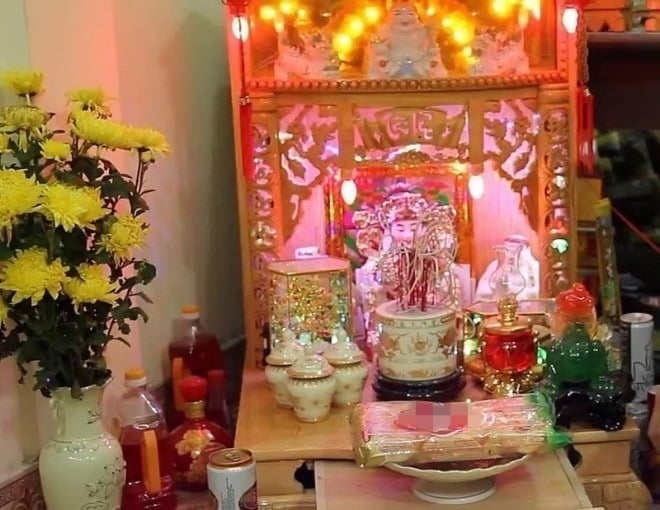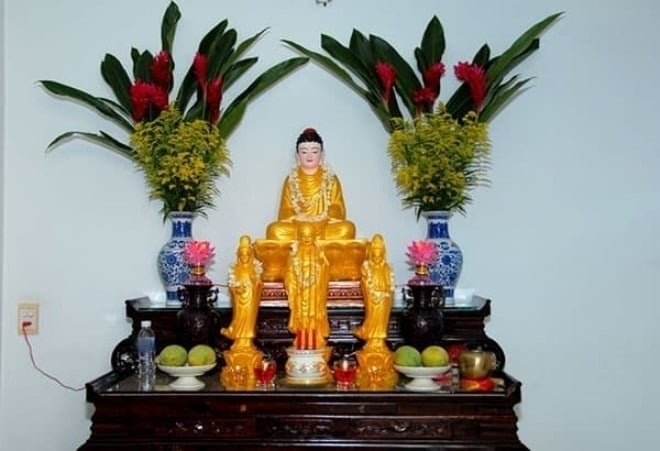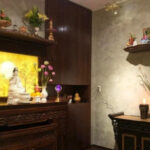In addition to flower arrangements, homeowners should also pay attention to other altar items such as the three-piece (or five-piece) altar set, offering trays, incense holders, etc., to enhance the solemnity and harmony of the worship space. For smaller altars, such as those hung on walls, a single flower vase and an incense holder placed opposite each other are sufficient.
It is important to avoid overcrowding the altar with too many flower vases, as this can not only fail to enhance the positive energy but also create an imbalance with the other worship items.
Flower vases should be made of ceramic, porcelain, or glass, avoiding materials like copper or iron. Flowers for the altar should have a gentle fragrance, be free of thorns, and be neatly trimmed to ensure both spiritual and physical safety within the worship space.
Why do wealthy families usually place a flower vase on the left side of the altar?
Wealthy families tend to place great emphasis on worship and rituals, believing that proper altar arrangement according to feng shui principles demonstrates respect for their ancestors and brings good fortune to the family.
When it comes to flower placement, if there is only one vase, it is typically placed on the left side of the altar. This arrangement follows the principle of “east for vases, west for fruit,” meaning that the flower vase should be placed in the east direction, while the fruit plate is placed in the west.

Wealthy families often pay great attention to worship and rituals, believing that proper altar arrangement according to feng shui brings good fortune.
The reason behind this is that the sun rises in the east and sets in the west, and trees usually flower before bearing fruit. Therefore, placing the flower vase in the east and the fruit plate in the west aligns with natural laws, ensuring smooth and favorable outcomes.
If the altar faces south, placing the flower vase on the left (east) will allow the floral fragrance to permeate the room, especially with winds from the east or southeast, adding solemnity and tranquility to the worship space.

Placing the flower vase on the left of a south-facing altar enhances the spread of floral fragrance, especially with eastern or southeastern winds.
When using two flower vases, they should be placed symmetrically on both sides, with the fruit tray in the center, in front of the incense holder. This arrangement not only makes the altar appear complete and inviting but also maintains the significance of the flower and fruit offerings.
“Don’t Make the Same Mistake: Why You Shouldn’t Place Your Altar Across From a Window”
The ancestral shrine room, according to Feng Shui principles, is a sacred space that demands tranquility and protection from strong winds and direct sunlight. It is a place of reverence, where the scent of incense during prayers can linger, creating a stuffy atmosphere, thus emphasizing the need for proper ventilation.
The Sweetest Fruit with a Beautiful Appearance, but a No-Go for Incense Burning: Why You Shouldn’t Place It on Your Ancestral Altar.
Selecting the right fruits for your ancestral altar requires careful consideration. Each fruit holds a unique symbolic meaning, and while some may be visually appealing or delicious, they might not be suitable for offering. Placing the wrong fruits on your altar could result in bad luck and financial loss.
Does Keeping a Knife by the Bedside Affect Feng Shui?
The practice of keeping cutlery by the bedside is not a prudent habit. It is imperative to understand that this seemingly innocuous habit can have unforeseen consequences. While it may seem convenient to have easy access to these utensils, there are far safer and more practical alternatives to consider. It is essential to explore these options to ensure the utmost safety and well-being.






































